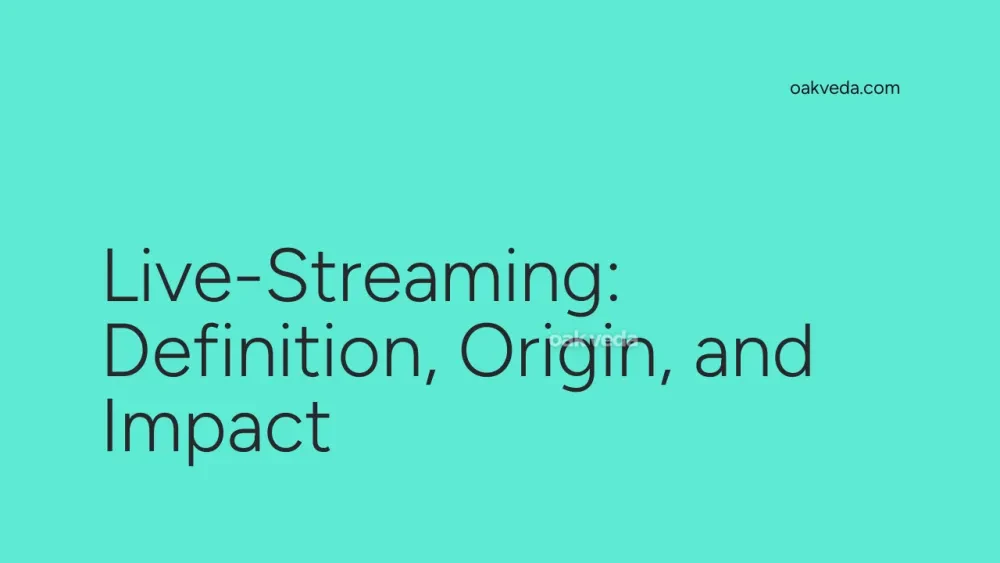
What is Live-Streaming?
Live-streaming is the real-time broadcasting of video and audio content over the internet. It allows individuals, businesses, and organizations to share events, performances, discussions, and various other content types with a remote audience who can watch and interact simultaneously. This technology has revolutionized how we consume and create content, blurring the lines between traditional media and user-generated content.
Origin and Development of Live-Streaming
The concept of live-streaming dates back to the 1990s, but it gained significant traction in the mid-2000s with the advent of high-speed internet and improved video compression technologies. Early platforms like Justin.tv (2007) paved the way for modern live-streaming services. The landscape dramatically changed with the launch of Twitch in 2011, which focused primarily on gaming content.
As smartphones became ubiquitous and mobile internet speeds increased, social media giants entered the live-streaming arena. Facebook Live launched in 2015, followed by Instagram Live in 2016 and TikTok Live in 2019. These developments democratized live-streaming, making it accessible to anyone with a smartphone and an internet connection.
How Live-Streaming Works
Live-streaming involves several key components:
- Video Source: This can be a smartphone camera, webcam, or professional video equipment.
- Encoding Software: Converts the raw video and audio into a digital format suitable for streaming.
- Content Delivery Network (CDN): Distributes the stream to viewers across different geographic locations.
- Streaming Platform: Hosts the live stream and provides an interface for viewers to watch and interact.
- Viewer's Device: Can be a smartphone, tablet, computer, or smart TV with an internet connection.
The process begins when the broadcaster starts the stream. The video and audio are captured, encoded in real-time, and sent to the streaming platform's servers. The platform then distributes the content through its CDN to viewers who access the stream through the platform's app or website.
Popular Live-Streaming Platforms
Several platforms have emerged as leaders in the live-streaming space:
- Twitch: Primarily focused on gaming content but has expanded to include creative arts, music, and talk shows.
- YouTube Live: Offers live-streaming capabilities to its vast user base, covering a wide range of topics.
- Facebook Live: Integrated into the world's largest social network, allowing easy access to large audiences.
- Instagram Live: Popular for influencers and brands to connect with their followers in real-time.
- TikTok Live: Brings live-streaming to the short-form video platform, often used for Q&As and performances.
Impact of Live-Streaming on Social Media Culture
Live-streaming has significantly impacted social media culture in several ways:
- Increased Authenticity: Live content is often perceived as more authentic and unfiltered compared to pre-recorded videos.
- Real-Time Engagement: Viewers can interact with creators through comments and reactions, fostering a sense of community.
- Democratization of Content Creation: Anyone can become a broadcaster, leading to diverse content and perspectives.
- New Forms of Entertainment: Live game streaming, virtual concerts, and live shopping have emerged as popular formats.
- Immediate News Dissemination: Live-streaming has become a crucial tool for citizen journalism and breaking news coverage.
How Brands and Influencers Use Live-Streaming
Brands and influencers have embraced live-streaming as a powerful marketing and engagement tool:
- Product Launches: Companies use live streams to unveil new products, generating excitement and immediate feedback.
- Behind-the-Scenes Content: Offering exclusive glimpses into production processes or daily operations.
- Q&A Sessions: Engaging directly with audiences to answer questions and build relationships.
- Live Shopping: Combining e-commerce with live-streaming for interactive shopping experiences.
- Virtual Events: Hosting conferences, workshops, and concerts in a live-streamed format.
Future Trends Related to Live-Streaming
The future of live-streaming looks promising, with several emerging trends:
- 5G Integration: Faster mobile internet will enable higher quality streams and reduce latency.
- AI-Enhanced Streams: Artificial intelligence could provide real-time translations, content moderation, and personalized viewer experiences.
- Virtual and Augmented Reality: Immersive live-streaming experiences that blur the line between physical and digital worlds.
- Micro-Streaming: Short, focused live streams tailored for platforms like TikTok and Instagram Stories.
- Blockchain and Tokenization: New monetization models using cryptocurrency and NFTs for content creators.
FAQs about Live-Streaming
-
Is live-streaming free? Many platforms offer free live-streaming capabilities, but some may have paid features or subscription models for advanced functionalities.
-
What equipment do I need to start live-streaming? At a minimum, you need a device with a camera (smartphone or computer) and a stable internet connection. For higher quality streams, you might invest in external microphones, lighting, and professional cameras.
-
Can I make money from live-streaming? Yes, many platforms offer monetization options such as donations, subscriptions, ad revenue sharing, and sponsored content.
-
How do I protect my privacy when live-streaming? Be mindful of your surroundings, use privacy settings provided by the platform, and consider using a VPN for added security.
-
What are the legal considerations for live-streaming? Respect copyright laws, obtain necessary permissions for music or content use, and be aware of platform-specific guidelines and community standards.
Live-streaming has become an integral part of our digital landscape, offering new ways to connect, create, and consume content. As technology continues to evolve, we can expect live-streaming to play an increasingly significant role in shaping our online experiences and interactions.
You may be interested in:
- Fandom: Definition, Origin, and Impact on Social Media
- Social Media Bio: Definition, Origin, and Impact
- NPS (Net Promoter Score): Definition, Origin, and Impact
- Stan Store: Definition, Origin, and Impact on Creator Economy
- Ghosting: Definition, Origin, and Impact on Social Media
- W in Social Media: Definition, Origin, and Impact

